Leading Innovation and Cultural Change: A Report on Tesco's Strategies
VerifiedAdded on 2023/01/04
|13
|4697
|75
Report
AI Summary
This report provides a comprehensive analysis of innovation and cultural change within Tesco, a major British grocery retailer. It begins with a background of the company, its organizational structure, and its global presence. The report delves into Tesco's innovation processes, examining how the company identifies market needs and develops new products and services, referencing the Innovation Process Model. Furthermore, the report explores Tesco's current change management practices, specifically focusing on the implementation of Lewin's change management model and Kotter's change management model to address potential changes, such as increasing employee working hours. The report also offers recommendations for the organization to improve its innovation and change management strategies and concludes with a summary of the key findings. The report emphasizes the importance of adapting to dynamic market conditions and ensuring customer satisfaction through effective change management and innovation.
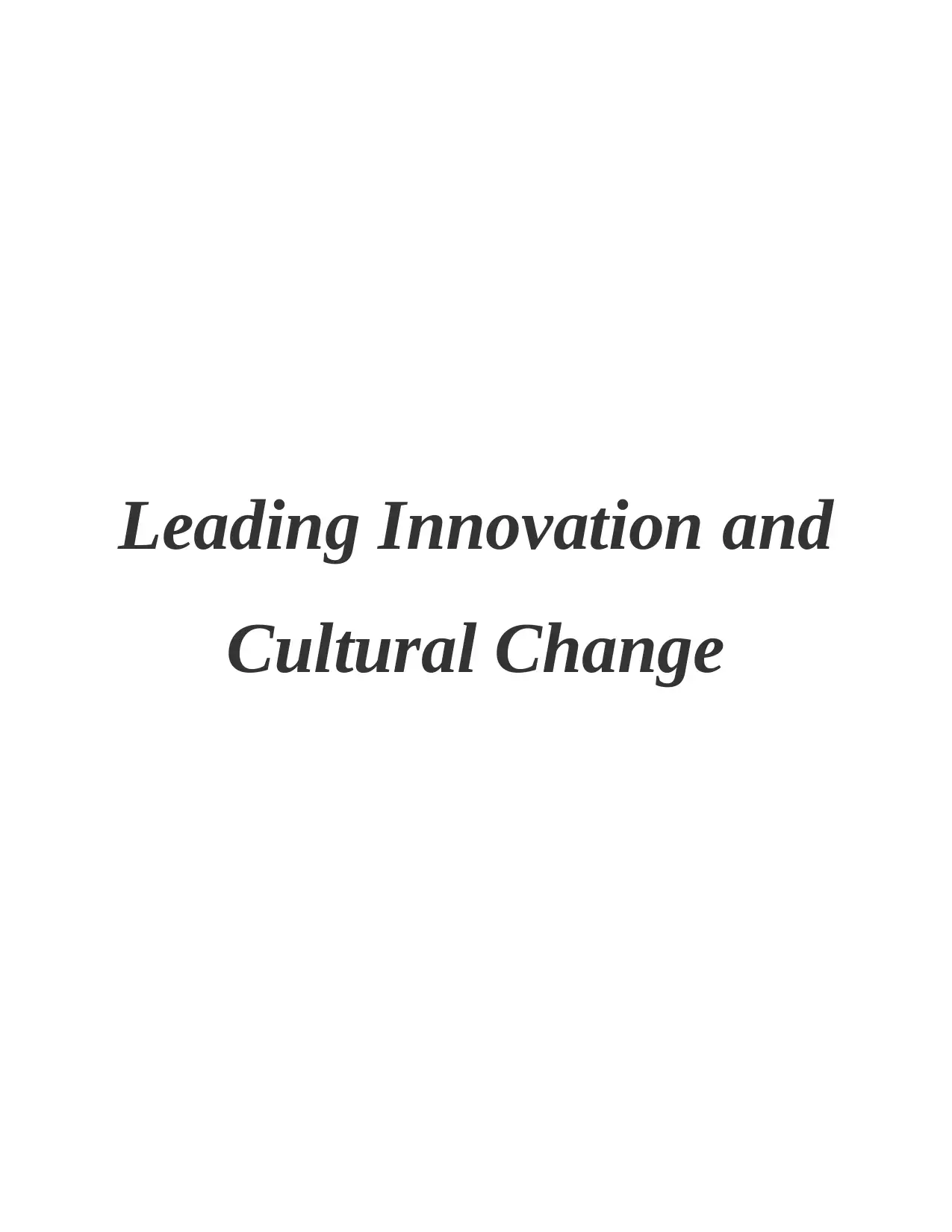
Leading Innovation and
Cultural Change
Cultural Change
Paraphrase This Document
Need a fresh take? Get an instant paraphrase of this document with our AI Paraphraser
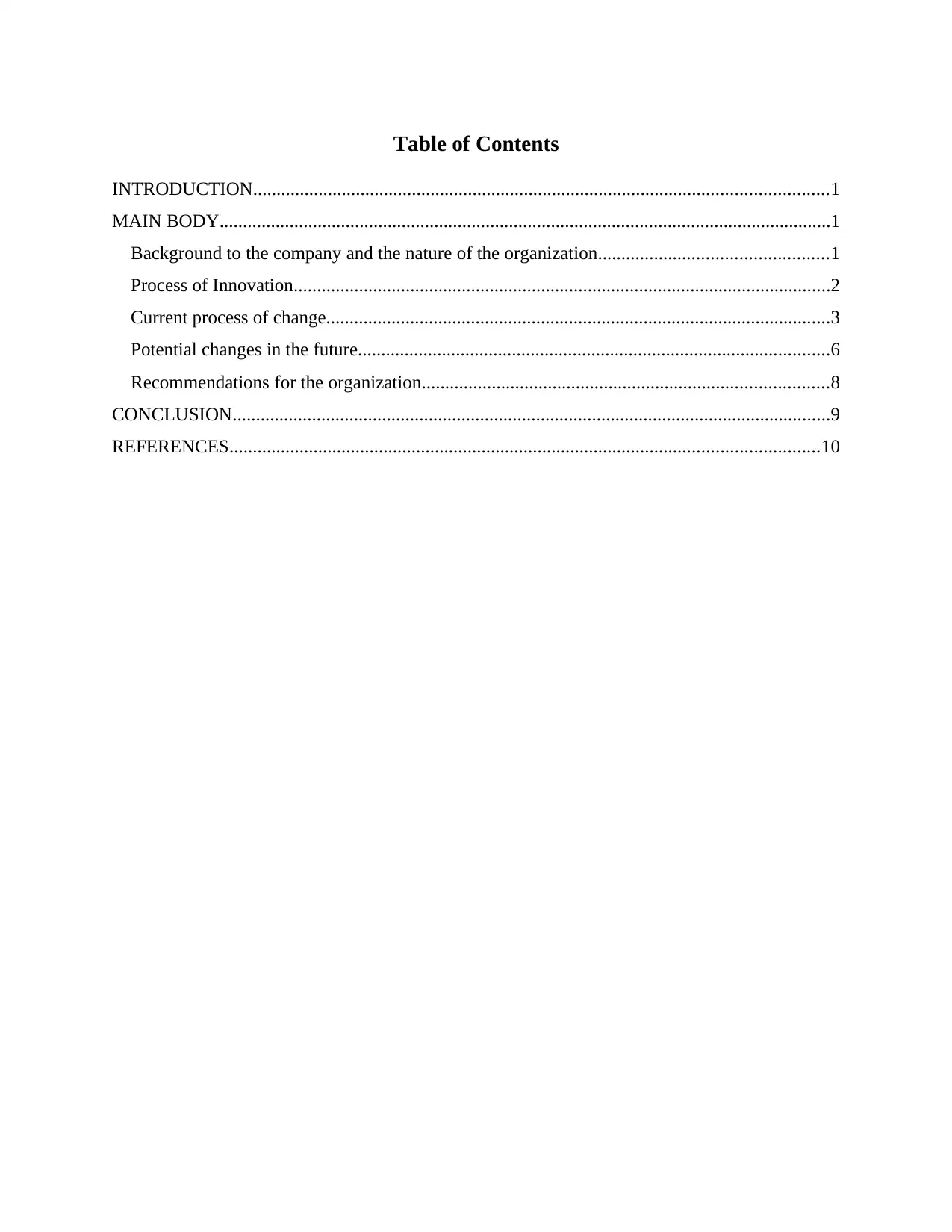
Table of Contents
INTRODUCTION...........................................................................................................................1
MAIN BODY...................................................................................................................................1
Background to the company and the nature of the organization.................................................1
Process of Innovation...................................................................................................................2
Current process of change............................................................................................................3
Potential changes in the future.....................................................................................................6
Recommendations for the organization.......................................................................................8
CONCLUSION................................................................................................................................9
REFERENCES..............................................................................................................................10
INTRODUCTION...........................................................................................................................1
MAIN BODY...................................................................................................................................1
Background to the company and the nature of the organization.................................................1
Process of Innovation...................................................................................................................2
Current process of change............................................................................................................3
Potential changes in the future.....................................................................................................6
Recommendations for the organization.......................................................................................8
CONCLUSION................................................................................................................................9
REFERENCES..............................................................................................................................10
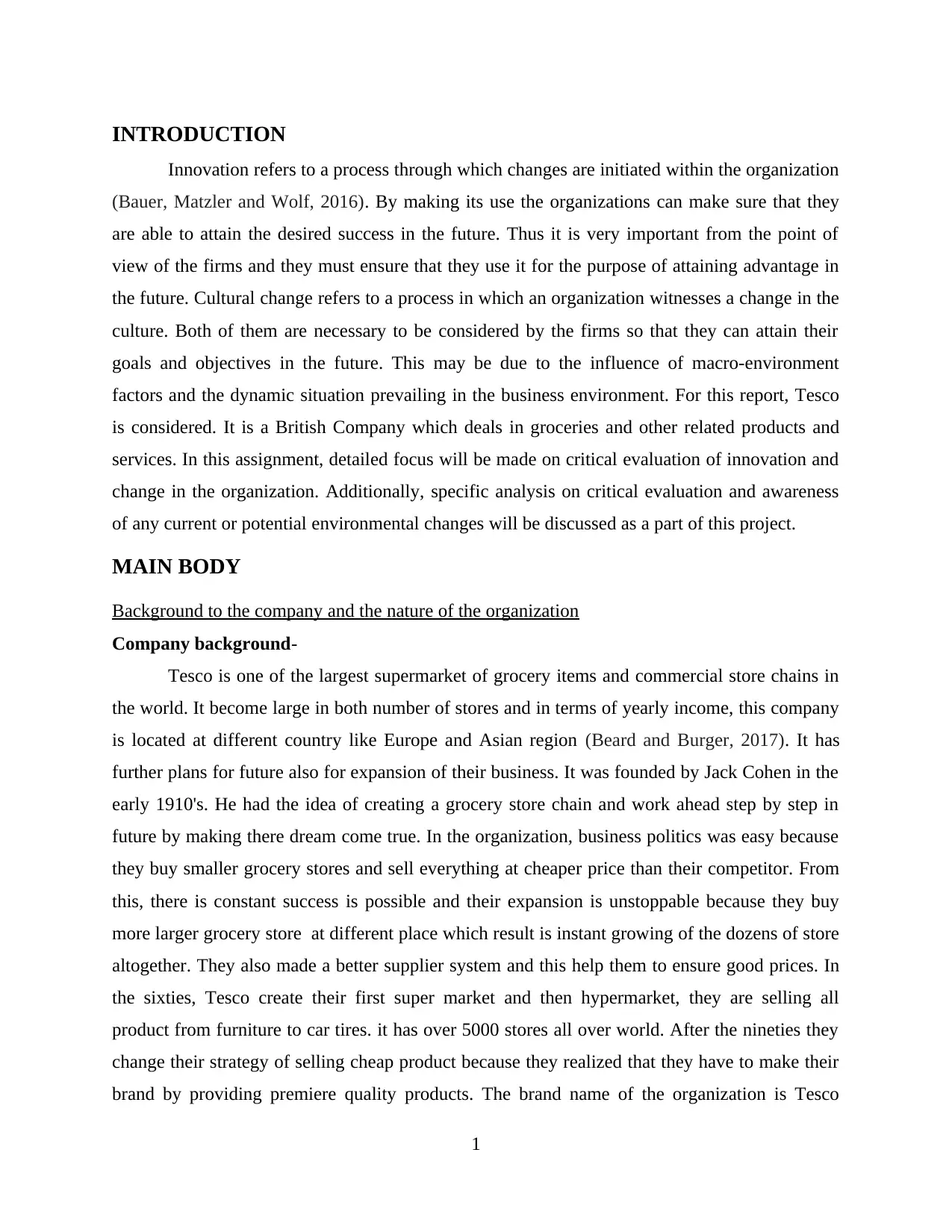
INTRODUCTION
Innovation refers to a process through which changes are initiated within the organization
(Bauer, Matzler and Wolf, 2016). By making its use the organizations can make sure that they
are able to attain the desired success in the future. Thus it is very important from the point of
view of the firms and they must ensure that they use it for the purpose of attaining advantage in
the future. Cultural change refers to a process in which an organization witnesses a change in the
culture. Both of them are necessary to be considered by the firms so that they can attain their
goals and objectives in the future. This may be due to the influence of macro-environment
factors and the dynamic situation prevailing in the business environment. For this report, Tesco
is considered. It is a British Company which deals in groceries and other related products and
services. In this assignment, detailed focus will be made on critical evaluation of innovation and
change in the organization. Additionally, specific analysis on critical evaluation and awareness
of any current or potential environmental changes will be discussed as a part of this project.
MAIN BODY
Background to the company and the nature of the organization
Company background-
Tesco is one of the largest supermarket of grocery items and commercial store chains in
the world. It become large in both number of stores and in terms of yearly income, this company
is located at different country like Europe and Asian region (Beard and Burger, 2017). It has
further plans for future also for expansion of their business. It was founded by Jack Cohen in the
early 1910's. He had the idea of creating a grocery store chain and work ahead step by step in
future by making there dream come true. In the organization, business politics was easy because
they buy smaller grocery stores and sell everything at cheaper price than their competitor. From
this, there is constant success is possible and their expansion is unstoppable because they buy
more larger grocery store at different place which result is instant growing of the dozens of store
altogether. They also made a better supplier system and this help them to ensure good prices. In
the sixties, Tesco create their first super market and then hypermarket, they are selling all
product from furniture to car tires. it has over 5000 stores all over world. After the nineties they
change their strategy of selling cheap product because they realized that they have to make their
brand by providing premiere quality products. The brand name of the organization is Tesco
1
Innovation refers to a process through which changes are initiated within the organization
(Bauer, Matzler and Wolf, 2016). By making its use the organizations can make sure that they
are able to attain the desired success in the future. Thus it is very important from the point of
view of the firms and they must ensure that they use it for the purpose of attaining advantage in
the future. Cultural change refers to a process in which an organization witnesses a change in the
culture. Both of them are necessary to be considered by the firms so that they can attain their
goals and objectives in the future. This may be due to the influence of macro-environment
factors and the dynamic situation prevailing in the business environment. For this report, Tesco
is considered. It is a British Company which deals in groceries and other related products and
services. In this assignment, detailed focus will be made on critical evaluation of innovation and
change in the organization. Additionally, specific analysis on critical evaluation and awareness
of any current or potential environmental changes will be discussed as a part of this project.
MAIN BODY
Background to the company and the nature of the organization
Company background-
Tesco is one of the largest supermarket of grocery items and commercial store chains in
the world. It become large in both number of stores and in terms of yearly income, this company
is located at different country like Europe and Asian region (Beard and Burger, 2017). It has
further plans for future also for expansion of their business. It was founded by Jack Cohen in the
early 1910's. He had the idea of creating a grocery store chain and work ahead step by step in
future by making there dream come true. In the organization, business politics was easy because
they buy smaller grocery stores and sell everything at cheaper price than their competitor. From
this, there is constant success is possible and their expansion is unstoppable because they buy
more larger grocery store at different place which result is instant growing of the dozens of store
altogether. They also made a better supplier system and this help them to ensure good prices. In
the sixties, Tesco create their first super market and then hypermarket, they are selling all
product from furniture to car tires. it has over 5000 stores all over world. After the nineties they
change their strategy of selling cheap product because they realized that they have to make their
brand by providing premiere quality products. The brand name of the organization is Tesco
1
⊘ This is a preview!⊘
Do you want full access?
Subscribe today to unlock all pages.

Trusted by 1+ million students worldwide
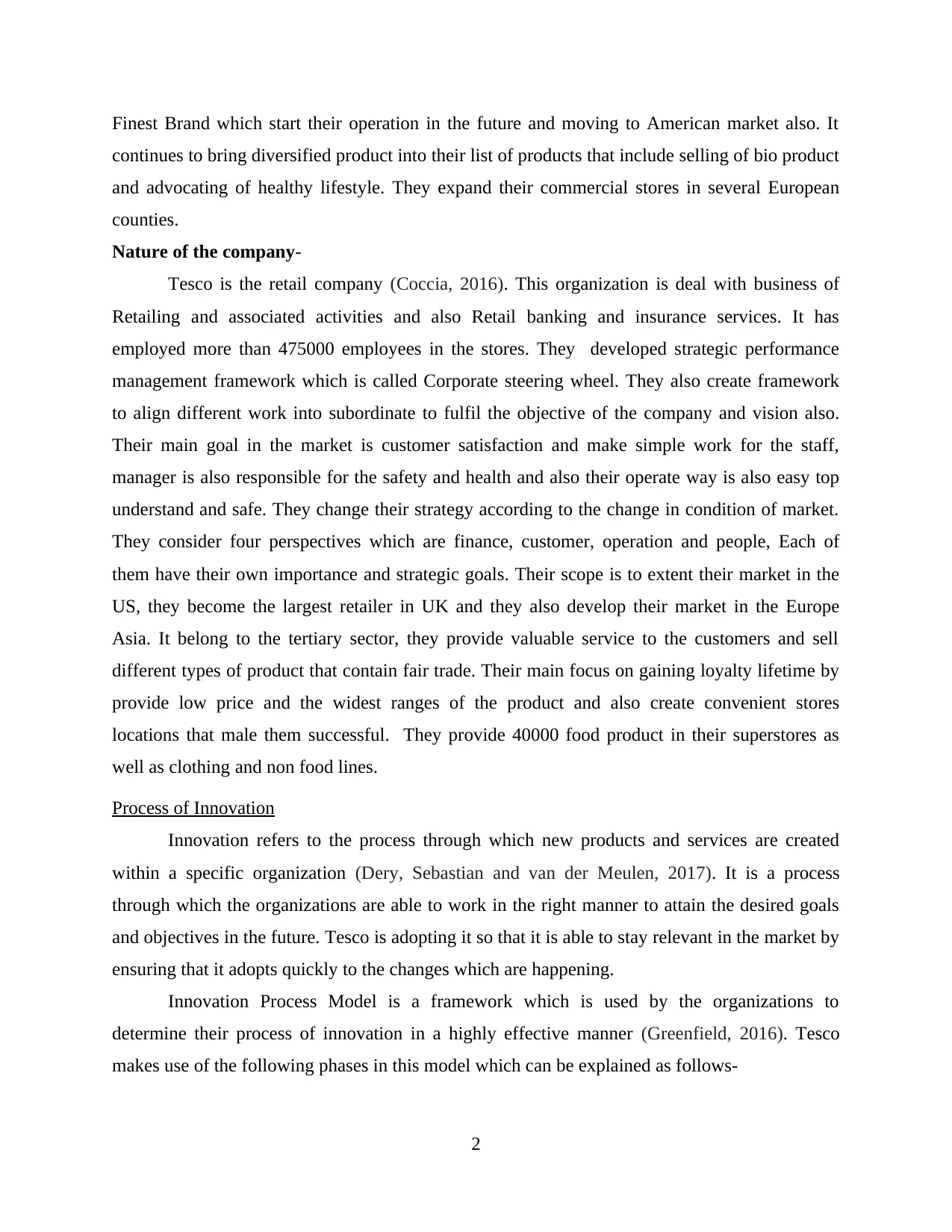
Finest Brand which start their operation in the future and moving to American market also. It
continues to bring diversified product into their list of products that include selling of bio product
and advocating of healthy lifestyle. They expand their commercial stores in several European
counties.
Nature of the company-
Tesco is the retail company (Coccia, 2016). This organization is deal with business of
Retailing and associated activities and also Retail banking and insurance services. It has
employed more than 475000 employees in the stores. They developed strategic performance
management framework which is called Corporate steering wheel. They also create framework
to align different work into subordinate to fulfil the objective of the company and vision also.
Their main goal in the market is customer satisfaction and make simple work for the staff,
manager is also responsible for the safety and health and also their operate way is also easy top
understand and safe. They change their strategy according to the change in condition of market.
They consider four perspectives which are finance, customer, operation and people, Each of
them have their own importance and strategic goals. Their scope is to extent their market in the
US, they become the largest retailer in UK and they also develop their market in the Europe
Asia. It belong to the tertiary sector, they provide valuable service to the customers and sell
different types of product that contain fair trade. Their main focus on gaining loyalty lifetime by
provide low price and the widest ranges of the product and also create convenient stores
locations that male them successful. They provide 40000 food product in their superstores as
well as clothing and non food lines.
Process of Innovation
Innovation refers to the process through which new products and services are created
within a specific organization (Dery, Sebastian and van der Meulen, 2017). It is a process
through which the organizations are able to work in the right manner to attain the desired goals
and objectives in the future. Tesco is adopting it so that it is able to stay relevant in the market by
ensuring that it adopts quickly to the changes which are happening.
Innovation Process Model is a framework which is used by the organizations to
determine their process of innovation in a highly effective manner (Greenfield, 2016). Tesco
makes use of the following phases in this model which can be explained as follows-
2
continues to bring diversified product into their list of products that include selling of bio product
and advocating of healthy lifestyle. They expand their commercial stores in several European
counties.
Nature of the company-
Tesco is the retail company (Coccia, 2016). This organization is deal with business of
Retailing and associated activities and also Retail banking and insurance services. It has
employed more than 475000 employees in the stores. They developed strategic performance
management framework which is called Corporate steering wheel. They also create framework
to align different work into subordinate to fulfil the objective of the company and vision also.
Their main goal in the market is customer satisfaction and make simple work for the staff,
manager is also responsible for the safety and health and also their operate way is also easy top
understand and safe. They change their strategy according to the change in condition of market.
They consider four perspectives which are finance, customer, operation and people, Each of
them have their own importance and strategic goals. Their scope is to extent their market in the
US, they become the largest retailer in UK and they also develop their market in the Europe
Asia. It belong to the tertiary sector, they provide valuable service to the customers and sell
different types of product that contain fair trade. Their main focus on gaining loyalty lifetime by
provide low price and the widest ranges of the product and also create convenient stores
locations that male them successful. They provide 40000 food product in their superstores as
well as clothing and non food lines.
Process of Innovation
Innovation refers to the process through which new products and services are created
within a specific organization (Dery, Sebastian and van der Meulen, 2017). It is a process
through which the organizations are able to work in the right manner to attain the desired goals
and objectives in the future. Tesco is adopting it so that it is able to stay relevant in the market by
ensuring that it adopts quickly to the changes which are happening.
Innovation Process Model is a framework which is used by the organizations to
determine their process of innovation in a highly effective manner (Greenfield, 2016). Tesco
makes use of the following phases in this model which can be explained as follows-
2
Paraphrase This Document
Need a fresh take? Get an instant paraphrase of this document with our AI Paraphraser
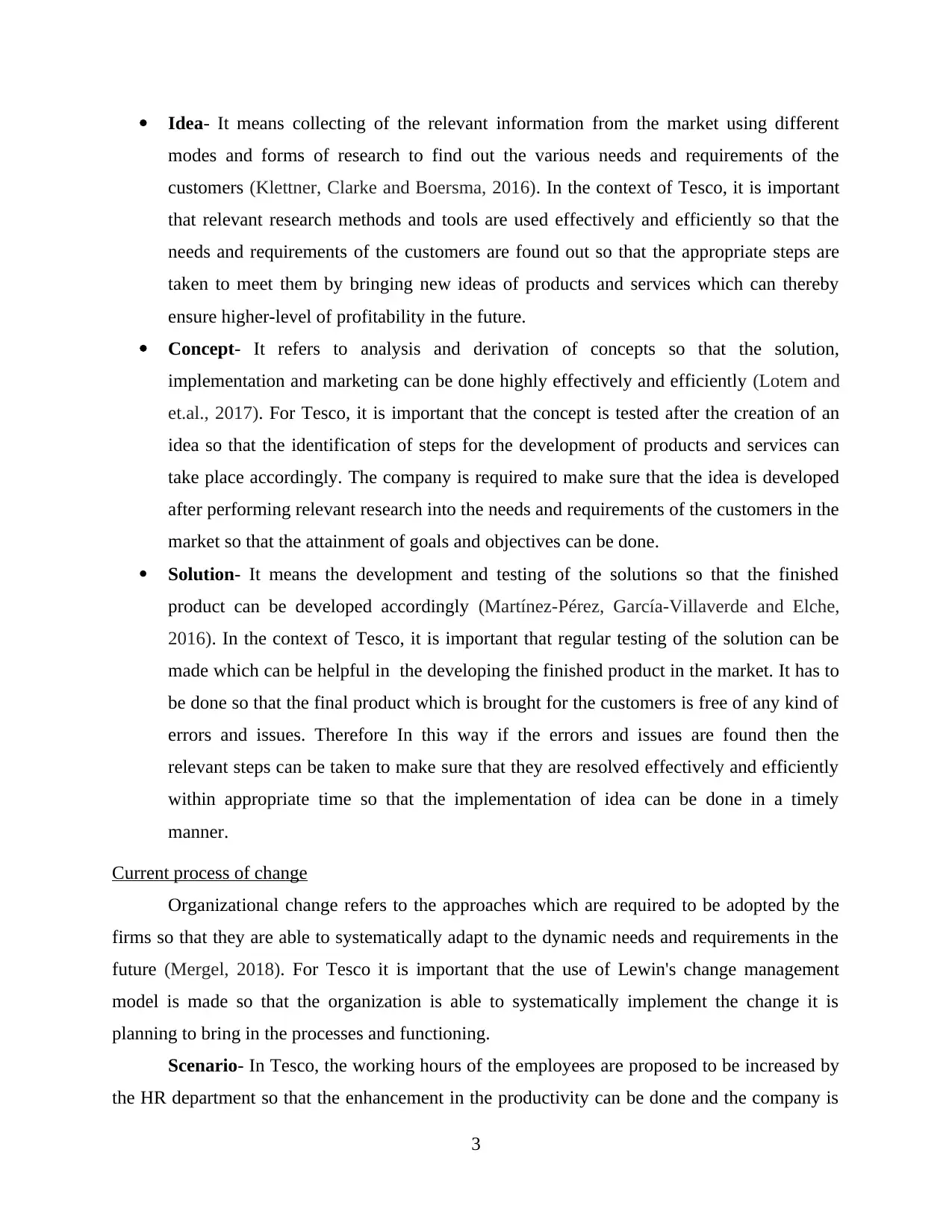
Idea- It means collecting of the relevant information from the market using different
modes and forms of research to find out the various needs and requirements of the
customers (Klettner, Clarke and Boersma, 2016). In the context of Tesco, it is important
that relevant research methods and tools are used effectively and efficiently so that the
needs and requirements of the customers are found out so that the appropriate steps are
taken to meet them by bringing new ideas of products and services which can thereby
ensure higher-level of profitability in the future.
Concept- It refers to analysis and derivation of concepts so that the solution,
implementation and marketing can be done highly effectively and efficiently (Lotem and
et.al., 2017). For Tesco, it is important that the concept is tested after the creation of an
idea so that the identification of steps for the development of products and services can
take place accordingly. The company is required to make sure that the idea is developed
after performing relevant research into the needs and requirements of the customers in the
market so that the attainment of goals and objectives can be done.
Solution- It means the development and testing of the solutions so that the finished
product can be developed accordingly (Martínez-Pérez, García-Villaverde and Elche,
2016). In the context of Tesco, it is important that regular testing of the solution can be
made which can be helpful in the developing the finished product in the market. It has to
be done so that the final product which is brought for the customers is free of any kind of
errors and issues. Therefore In this way if the errors and issues are found then the
relevant steps can be taken to make sure that they are resolved effectively and efficiently
within appropriate time so that the implementation of idea can be done in a timely
manner.
Current process of change
Organizational change refers to the approaches which are required to be adopted by the
firms so that they are able to systematically adapt to the dynamic needs and requirements in the
future (Mergel, 2018). For Tesco it is important that the use of Lewin's change management
model is made so that the organization is able to systematically implement the change it is
planning to bring in the processes and functioning.
Scenario- In Tesco, the working hours of the employees are proposed to be increased by
the HR department so that the enhancement in the productivity can be done and the company is
3
modes and forms of research to find out the various needs and requirements of the
customers (Klettner, Clarke and Boersma, 2016). In the context of Tesco, it is important
that relevant research methods and tools are used effectively and efficiently so that the
needs and requirements of the customers are found out so that the appropriate steps are
taken to meet them by bringing new ideas of products and services which can thereby
ensure higher-level of profitability in the future.
Concept- It refers to analysis and derivation of concepts so that the solution,
implementation and marketing can be done highly effectively and efficiently (Lotem and
et.al., 2017). For Tesco, it is important that the concept is tested after the creation of an
idea so that the identification of steps for the development of products and services can
take place accordingly. The company is required to make sure that the idea is developed
after performing relevant research into the needs and requirements of the customers in the
market so that the attainment of goals and objectives can be done.
Solution- It means the development and testing of the solutions so that the finished
product can be developed accordingly (Martínez-Pérez, García-Villaverde and Elche,
2016). In the context of Tesco, it is important that regular testing of the solution can be
made which can be helpful in the developing the finished product in the market. It has to
be done so that the final product which is brought for the customers is free of any kind of
errors and issues. Therefore In this way if the errors and issues are found then the
relevant steps can be taken to make sure that they are resolved effectively and efficiently
within appropriate time so that the implementation of idea can be done in a timely
manner.
Current process of change
Organizational change refers to the approaches which are required to be adopted by the
firms so that they are able to systematically adapt to the dynamic needs and requirements in the
future (Mergel, 2018). For Tesco it is important that the use of Lewin's change management
model is made so that the organization is able to systematically implement the change it is
planning to bring in the processes and functioning.
Scenario- In Tesco, the working hours of the employees are proposed to be increased by
the HR department so that the enhancement in the productivity can be done and the company is
3
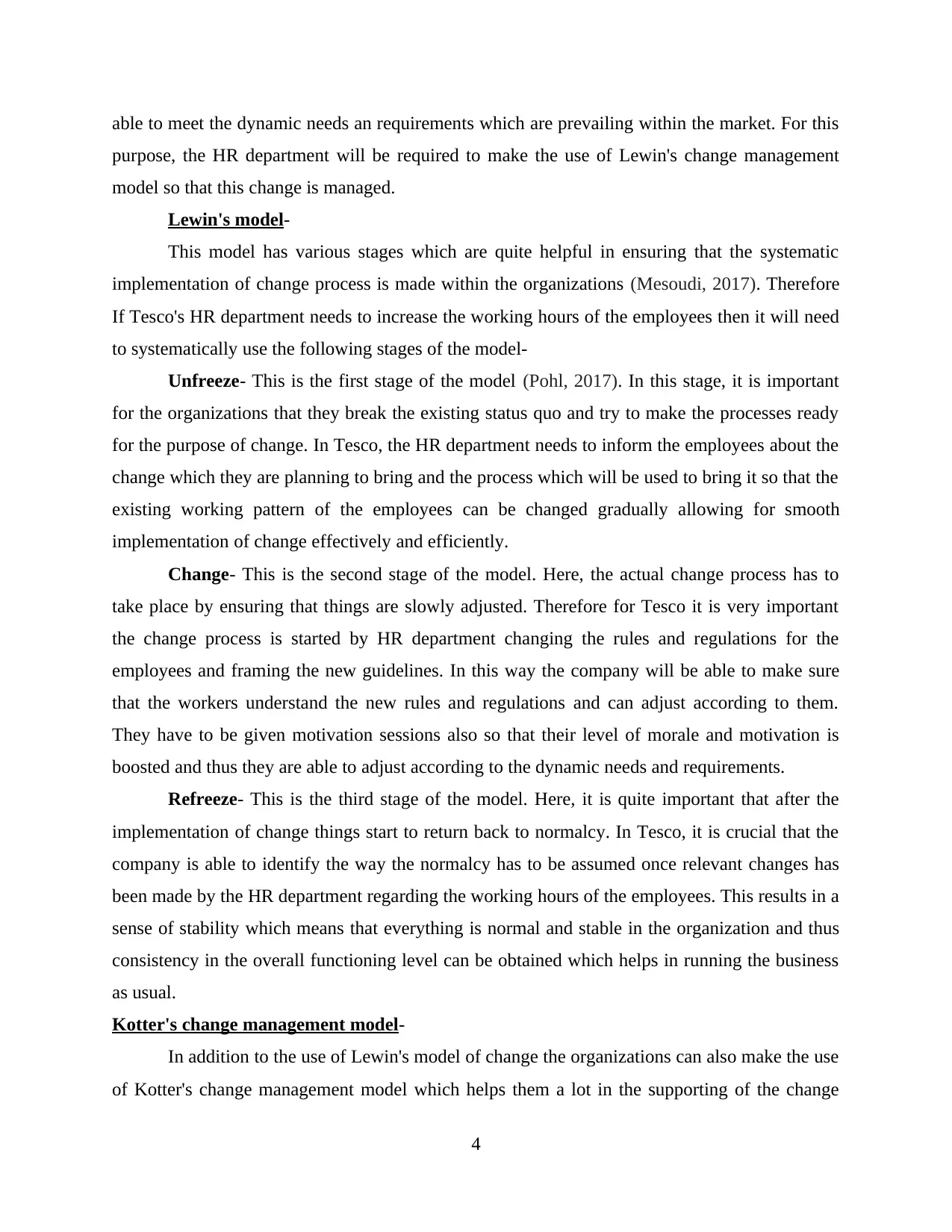
able to meet the dynamic needs an requirements which are prevailing within the market. For this
purpose, the HR department will be required to make the use of Lewin's change management
model so that this change is managed.
Lewin's model-
This model has various stages which are quite helpful in ensuring that the systematic
implementation of change process is made within the organizations (Mesoudi, 2017). Therefore
If Tesco's HR department needs to increase the working hours of the employees then it will need
to systematically use the following stages of the model-
Unfreeze- This is the first stage of the model (Pohl, 2017). In this stage, it is important
for the organizations that they break the existing status quo and try to make the processes ready
for the purpose of change. In Tesco, the HR department needs to inform the employees about the
change which they are planning to bring and the process which will be used to bring it so that the
existing working pattern of the employees can be changed gradually allowing for smooth
implementation of change effectively and efficiently.
Change- This is the second stage of the model. Here, the actual change process has to
take place by ensuring that things are slowly adjusted. Therefore for Tesco it is very important
the change process is started by HR department changing the rules and regulations for the
employees and framing the new guidelines. In this way the company will be able to make sure
that the workers understand the new rules and regulations and can adjust according to them.
They have to be given motivation sessions also so that their level of morale and motivation is
boosted and thus they are able to adjust according to the dynamic needs and requirements.
Refreeze- This is the third stage of the model. Here, it is quite important that after the
implementation of change things start to return back to normalcy. In Tesco, it is crucial that the
company is able to identify the way the normalcy has to be assumed once relevant changes has
been made by the HR department regarding the working hours of the employees. This results in a
sense of stability which means that everything is normal and stable in the organization and thus
consistency in the overall functioning level can be obtained which helps in running the business
as usual.
Kotter's change management model-
In addition to the use of Lewin's model of change the organizations can also make the use
of Kotter's change management model which helps them a lot in the supporting of the change
4
purpose, the HR department will be required to make the use of Lewin's change management
model so that this change is managed.
Lewin's model-
This model has various stages which are quite helpful in ensuring that the systematic
implementation of change process is made within the organizations (Mesoudi, 2017). Therefore
If Tesco's HR department needs to increase the working hours of the employees then it will need
to systematically use the following stages of the model-
Unfreeze- This is the first stage of the model (Pohl, 2017). In this stage, it is important
for the organizations that they break the existing status quo and try to make the processes ready
for the purpose of change. In Tesco, the HR department needs to inform the employees about the
change which they are planning to bring and the process which will be used to bring it so that the
existing working pattern of the employees can be changed gradually allowing for smooth
implementation of change effectively and efficiently.
Change- This is the second stage of the model. Here, the actual change process has to
take place by ensuring that things are slowly adjusted. Therefore for Tesco it is very important
the change process is started by HR department changing the rules and regulations for the
employees and framing the new guidelines. In this way the company will be able to make sure
that the workers understand the new rules and regulations and can adjust according to them.
They have to be given motivation sessions also so that their level of morale and motivation is
boosted and thus they are able to adjust according to the dynamic needs and requirements.
Refreeze- This is the third stage of the model. Here, it is quite important that after the
implementation of change things start to return back to normalcy. In Tesco, it is crucial that the
company is able to identify the way the normalcy has to be assumed once relevant changes has
been made by the HR department regarding the working hours of the employees. This results in a
sense of stability which means that everything is normal and stable in the organization and thus
consistency in the overall functioning level can be obtained which helps in running the business
as usual.
Kotter's change management model-
In addition to the use of Lewin's model of change the organizations can also make the use
of Kotter's change management model which helps them a lot in the supporting of the change
4
⊘ This is a preview!⊘
Do you want full access?
Subscribe today to unlock all pages.

Trusted by 1+ million students worldwide
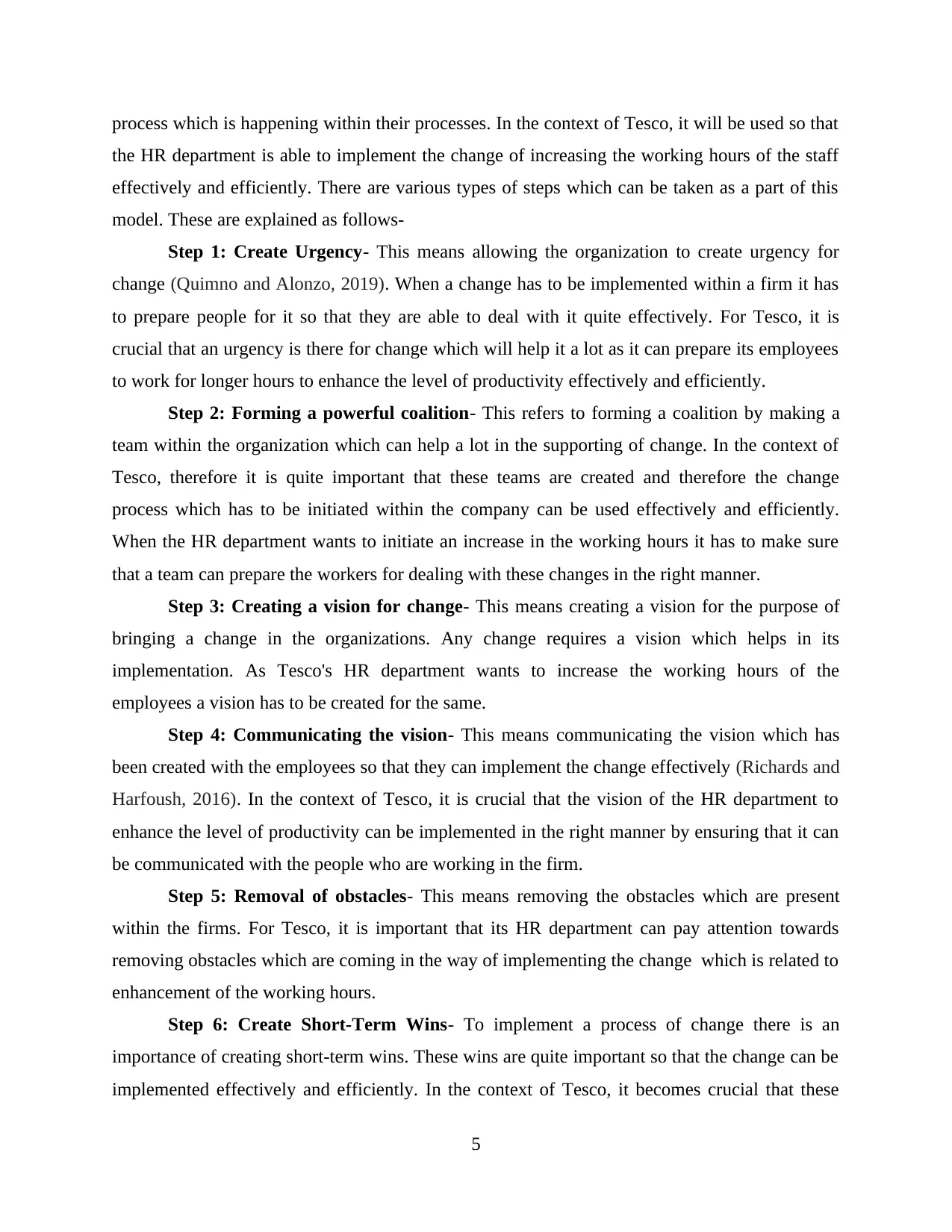
process which is happening within their processes. In the context of Tesco, it will be used so that
the HR department is able to implement the change of increasing the working hours of the staff
effectively and efficiently. There are various types of steps which can be taken as a part of this
model. These are explained as follows-
Step 1: Create Urgency- This means allowing the organization to create urgency for
change (Quimno and Alonzo, 2019). When a change has to be implemented within a firm it has
to prepare people for it so that they are able to deal with it quite effectively. For Tesco, it is
crucial that an urgency is there for change which will help it a lot as it can prepare its employees
to work for longer hours to enhance the level of productivity effectively and efficiently.
Step 2: Forming a powerful coalition- This refers to forming a coalition by making a
team within the organization which can help a lot in the supporting of change. In the context of
Tesco, therefore it is quite important that these teams are created and therefore the change
process which has to be initiated within the company can be used effectively and efficiently.
When the HR department wants to initiate an increase in the working hours it has to make sure
that a team can prepare the workers for dealing with these changes in the right manner.
Step 3: Creating a vision for change- This means creating a vision for the purpose of
bringing a change in the organizations. Any change requires a vision which helps in its
implementation. As Tesco's HR department wants to increase the working hours of the
employees a vision has to be created for the same.
Step 4: Communicating the vision- This means communicating the vision which has
been created with the employees so that they can implement the change effectively (Richards and
Harfoush, 2016). In the context of Tesco, it is crucial that the vision of the HR department to
enhance the level of productivity can be implemented in the right manner by ensuring that it can
be communicated with the people who are working in the firm.
Step 5: Removal of obstacles- This means removing the obstacles which are present
within the firms. For Tesco, it is important that its HR department can pay attention towards
removing obstacles which are coming in the way of implementing the change which is related to
enhancement of the working hours.
Step 6: Create Short-Term Wins- To implement a process of change there is an
importance of creating short-term wins. These wins are quite important so that the change can be
implemented effectively and efficiently. In the context of Tesco, it becomes crucial that these
5
the HR department is able to implement the change of increasing the working hours of the staff
effectively and efficiently. There are various types of steps which can be taken as a part of this
model. These are explained as follows-
Step 1: Create Urgency- This means allowing the organization to create urgency for
change (Quimno and Alonzo, 2019). When a change has to be implemented within a firm it has
to prepare people for it so that they are able to deal with it quite effectively. For Tesco, it is
crucial that an urgency is there for change which will help it a lot as it can prepare its employees
to work for longer hours to enhance the level of productivity effectively and efficiently.
Step 2: Forming a powerful coalition- This refers to forming a coalition by making a
team within the organization which can help a lot in the supporting of change. In the context of
Tesco, therefore it is quite important that these teams are created and therefore the change
process which has to be initiated within the company can be used effectively and efficiently.
When the HR department wants to initiate an increase in the working hours it has to make sure
that a team can prepare the workers for dealing with these changes in the right manner.
Step 3: Creating a vision for change- This means creating a vision for the purpose of
bringing a change in the organizations. Any change requires a vision which helps in its
implementation. As Tesco's HR department wants to increase the working hours of the
employees a vision has to be created for the same.
Step 4: Communicating the vision- This means communicating the vision which has
been created with the employees so that they can implement the change effectively (Richards and
Harfoush, 2016). In the context of Tesco, it is crucial that the vision of the HR department to
enhance the level of productivity can be implemented in the right manner by ensuring that it can
be communicated with the people who are working in the firm.
Step 5: Removal of obstacles- This means removing the obstacles which are present
within the firms. For Tesco, it is important that its HR department can pay attention towards
removing obstacles which are coming in the way of implementing the change which is related to
enhancement of the working hours.
Step 6: Create Short-Term Wins- To implement a process of change there is an
importance of creating short-term wins. These wins are quite important so that the change can be
implemented effectively and efficiently. In the context of Tesco, it becomes crucial that these
5
Paraphrase This Document
Need a fresh take? Get an instant paraphrase of this document with our AI Paraphraser
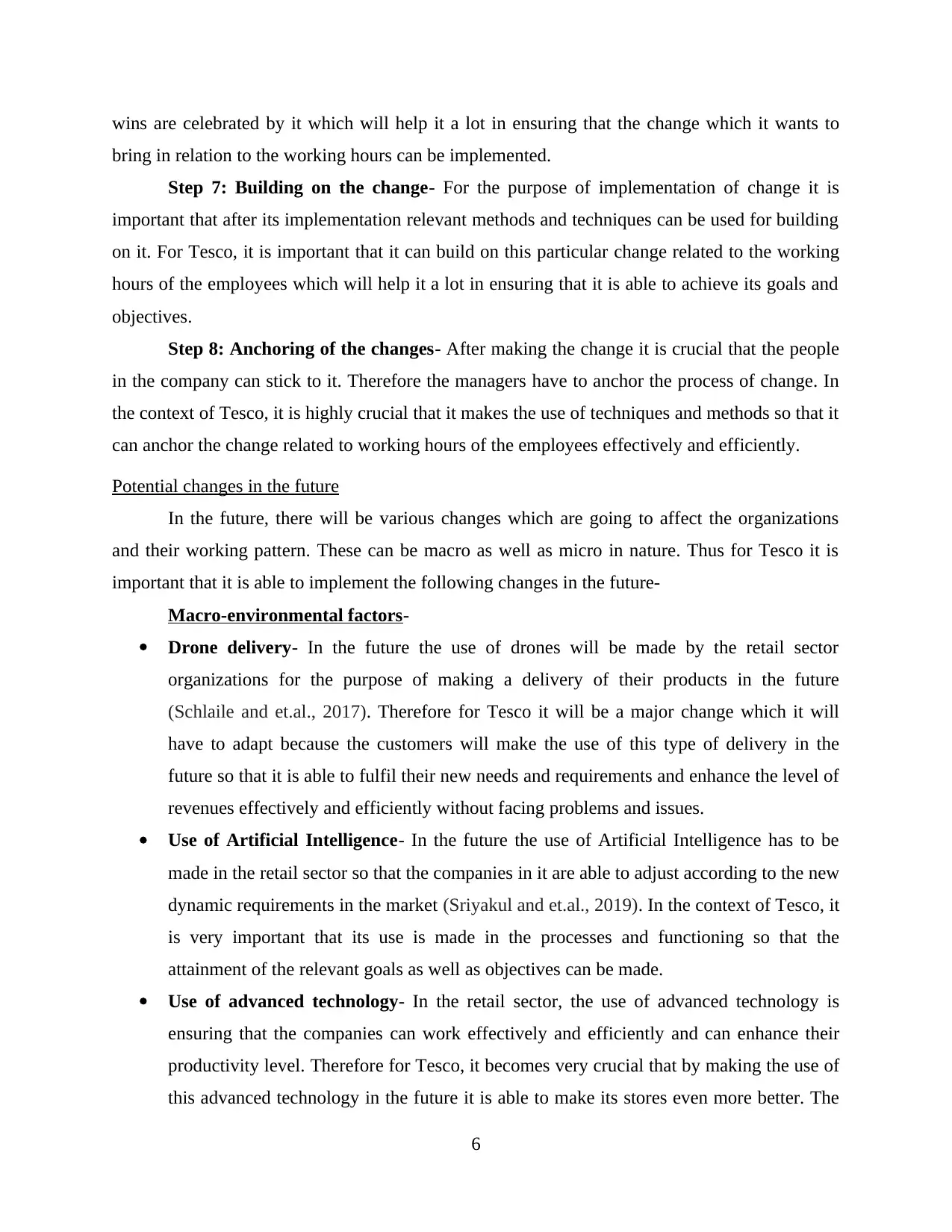
wins are celebrated by it which will help it a lot in ensuring that the change which it wants to
bring in relation to the working hours can be implemented.
Step 7: Building on the change- For the purpose of implementation of change it is
important that after its implementation relevant methods and techniques can be used for building
on it. For Tesco, it is important that it can build on this particular change related to the working
hours of the employees which will help it a lot in ensuring that it is able to achieve its goals and
objectives.
Step 8: Anchoring of the changes- After making the change it is crucial that the people
in the company can stick to it. Therefore the managers have to anchor the process of change. In
the context of Tesco, it is highly crucial that it makes the use of techniques and methods so that it
can anchor the change related to working hours of the employees effectively and efficiently.
Potential changes in the future
In the future, there will be various changes which are going to affect the organizations
and their working pattern. These can be macro as well as micro in nature. Thus for Tesco it is
important that it is able to implement the following changes in the future-
Macro-environmental factors-
Drone delivery- In the future the use of drones will be made by the retail sector
organizations for the purpose of making a delivery of their products in the future
(Schlaile and et.al., 2017). Therefore for Tesco it will be a major change which it will
have to adapt because the customers will make the use of this type of delivery in the
future so that it is able to fulfil their new needs and requirements and enhance the level of
revenues effectively and efficiently without facing problems and issues.
Use of Artificial Intelligence- In the future the use of Artificial Intelligence has to be
made in the retail sector so that the companies in it are able to adjust according to the new
dynamic requirements in the market (Sriyakul and et.al., 2019). In the context of Tesco, it
is very important that its use is made in the processes and functioning so that the
attainment of the relevant goals as well as objectives can be made.
Use of advanced technology- In the retail sector, the use of advanced technology is
ensuring that the companies can work effectively and efficiently and can enhance their
productivity level. Therefore for Tesco, it becomes very crucial that by making the use of
this advanced technology in the future it is able to make its stores even more better. The
6
bring in relation to the working hours can be implemented.
Step 7: Building on the change- For the purpose of implementation of change it is
important that after its implementation relevant methods and techniques can be used for building
on it. For Tesco, it is important that it can build on this particular change related to the working
hours of the employees which will help it a lot in ensuring that it is able to achieve its goals and
objectives.
Step 8: Anchoring of the changes- After making the change it is crucial that the people
in the company can stick to it. Therefore the managers have to anchor the process of change. In
the context of Tesco, it is highly crucial that it makes the use of techniques and methods so that it
can anchor the change related to working hours of the employees effectively and efficiently.
Potential changes in the future
In the future, there will be various changes which are going to affect the organizations
and their working pattern. These can be macro as well as micro in nature. Thus for Tesco it is
important that it is able to implement the following changes in the future-
Macro-environmental factors-
Drone delivery- In the future the use of drones will be made by the retail sector
organizations for the purpose of making a delivery of their products in the future
(Schlaile and et.al., 2017). Therefore for Tesco it will be a major change which it will
have to adapt because the customers will make the use of this type of delivery in the
future so that it is able to fulfil their new needs and requirements and enhance the level of
revenues effectively and efficiently without facing problems and issues.
Use of Artificial Intelligence- In the future the use of Artificial Intelligence has to be
made in the retail sector so that the companies in it are able to adjust according to the new
dynamic requirements in the market (Sriyakul and et.al., 2019). In the context of Tesco, it
is very important that its use is made in the processes and functioning so that the
attainment of the relevant goals as well as objectives can be made.
Use of advanced technology- In the retail sector, the use of advanced technology is
ensuring that the companies can work effectively and efficiently and can enhance their
productivity level. Therefore for Tesco, it becomes very crucial that by making the use of
this advanced technology in the future it is able to make its stores even more better. The
6
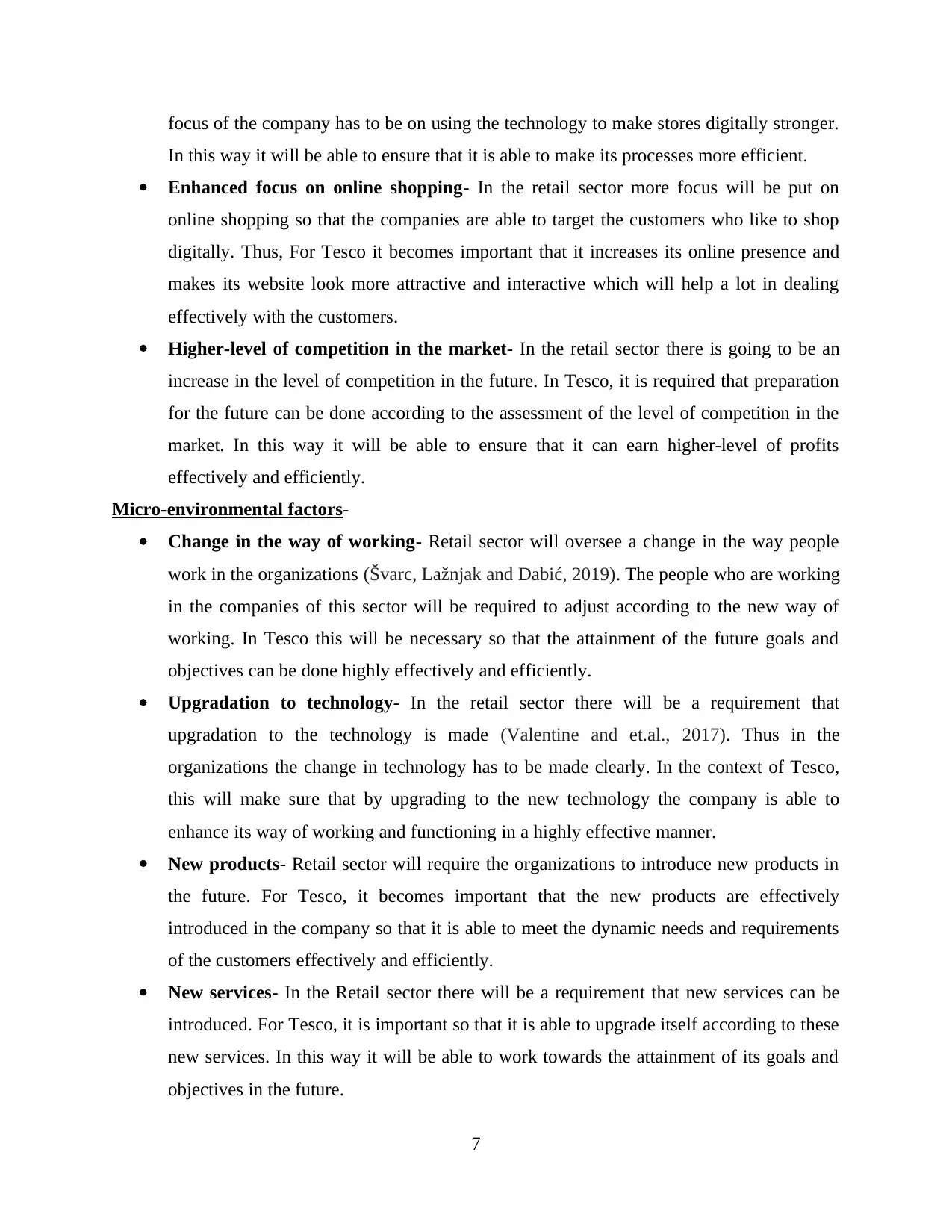
focus of the company has to be on using the technology to make stores digitally stronger.
In this way it will be able to ensure that it is able to make its processes more efficient.
Enhanced focus on online shopping- In the retail sector more focus will be put on
online shopping so that the companies are able to target the customers who like to shop
digitally. Thus, For Tesco it becomes important that it increases its online presence and
makes its website look more attractive and interactive which will help a lot in dealing
effectively with the customers.
Higher-level of competition in the market- In the retail sector there is going to be an
increase in the level of competition in the future. In Tesco, it is required that preparation
for the future can be done according to the assessment of the level of competition in the
market. In this way it will be able to ensure that it can earn higher-level of profits
effectively and efficiently.
Micro-environmental factors-
Change in the way of working- Retail sector will oversee a change in the way people
work in the organizations (Švarc, Lažnjak and Dabić, 2019). The people who are working
in the companies of this sector will be required to adjust according to the new way of
working. In Tesco this will be necessary so that the attainment of the future goals and
objectives can be done highly effectively and efficiently.
Upgradation to technology- In the retail sector there will be a requirement that
upgradation to the technology is made (Valentine and et.al., 2017). Thus in the
organizations the change in technology has to be made clearly. In the context of Tesco,
this will make sure that by upgrading to the new technology the company is able to
enhance its way of working and functioning in a highly effective manner.
New products- Retail sector will require the organizations to introduce new products in
the future. For Tesco, it becomes important that the new products are effectively
introduced in the company so that it is able to meet the dynamic needs and requirements
of the customers effectively and efficiently.
New services- In the Retail sector there will be a requirement that new services can be
introduced. For Tesco, it is important so that it is able to upgrade itself according to these
new services. In this way it will be able to work towards the attainment of its goals and
objectives in the future.
7
In this way it will be able to ensure that it is able to make its processes more efficient.
Enhanced focus on online shopping- In the retail sector more focus will be put on
online shopping so that the companies are able to target the customers who like to shop
digitally. Thus, For Tesco it becomes important that it increases its online presence and
makes its website look more attractive and interactive which will help a lot in dealing
effectively with the customers.
Higher-level of competition in the market- In the retail sector there is going to be an
increase in the level of competition in the future. In Tesco, it is required that preparation
for the future can be done according to the assessment of the level of competition in the
market. In this way it will be able to ensure that it can earn higher-level of profits
effectively and efficiently.
Micro-environmental factors-
Change in the way of working- Retail sector will oversee a change in the way people
work in the organizations (Švarc, Lažnjak and Dabić, 2019). The people who are working
in the companies of this sector will be required to adjust according to the new way of
working. In Tesco this will be necessary so that the attainment of the future goals and
objectives can be done highly effectively and efficiently.
Upgradation to technology- In the retail sector there will be a requirement that
upgradation to the technology is made (Valentine and et.al., 2017). Thus in the
organizations the change in technology has to be made clearly. In the context of Tesco,
this will make sure that by upgrading to the new technology the company is able to
enhance its way of working and functioning in a highly effective manner.
New products- Retail sector will require the organizations to introduce new products in
the future. For Tesco, it becomes important that the new products are effectively
introduced in the company so that it is able to meet the dynamic needs and requirements
of the customers effectively and efficiently.
New services- In the Retail sector there will be a requirement that new services can be
introduced. For Tesco, it is important so that it is able to upgrade itself according to these
new services. In this way it will be able to work towards the attainment of its goals and
objectives in the future.
7
⊘ This is a preview!⊘
Do you want full access?
Subscribe today to unlock all pages.

Trusted by 1+ million students worldwide
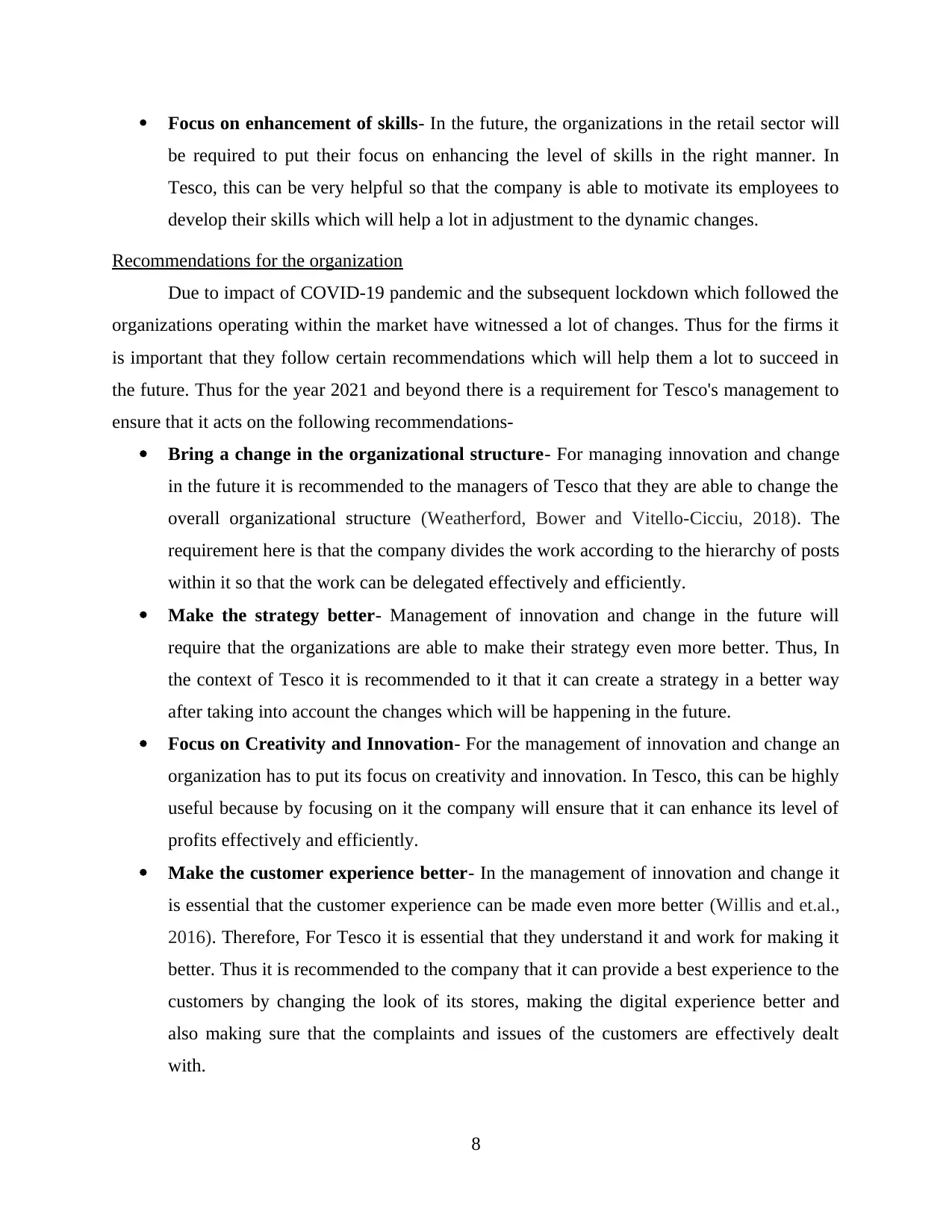
Focus on enhancement of skills- In the future, the organizations in the retail sector will
be required to put their focus on enhancing the level of skills in the right manner. In
Tesco, this can be very helpful so that the company is able to motivate its employees to
develop their skills which will help a lot in adjustment to the dynamic changes.
Recommendations for the organization
Due to impact of COVID-19 pandemic and the subsequent lockdown which followed the
organizations operating within the market have witnessed a lot of changes. Thus for the firms it
is important that they follow certain recommendations which will help them a lot to succeed in
the future. Thus for the year 2021 and beyond there is a requirement for Tesco's management to
ensure that it acts on the following recommendations-
Bring a change in the organizational structure- For managing innovation and change
in the future it is recommended to the managers of Tesco that they are able to change the
overall organizational structure (Weatherford, Bower and Vitello-Cicciu, 2018). The
requirement here is that the company divides the work according to the hierarchy of posts
within it so that the work can be delegated effectively and efficiently.
Make the strategy better- Management of innovation and change in the future will
require that the organizations are able to make their strategy even more better. Thus, In
the context of Tesco it is recommended to it that it can create a strategy in a better way
after taking into account the changes which will be happening in the future.
Focus on Creativity and Innovation- For the management of innovation and change an
organization has to put its focus on creativity and innovation. In Tesco, this can be highly
useful because by focusing on it the company will ensure that it can enhance its level of
profits effectively and efficiently.
Make the customer experience better- In the management of innovation and change it
is essential that the customer experience can be made even more better (Willis and et.al.,
2016). Therefore, For Tesco it is essential that they understand it and work for making it
better. Thus it is recommended to the company that it can provide a best experience to the
customers by changing the look of its stores, making the digital experience better and
also making sure that the complaints and issues of the customers are effectively dealt
with.
8
be required to put their focus on enhancing the level of skills in the right manner. In
Tesco, this can be very helpful so that the company is able to motivate its employees to
develop their skills which will help a lot in adjustment to the dynamic changes.
Recommendations for the organization
Due to impact of COVID-19 pandemic and the subsequent lockdown which followed the
organizations operating within the market have witnessed a lot of changes. Thus for the firms it
is important that they follow certain recommendations which will help them a lot to succeed in
the future. Thus for the year 2021 and beyond there is a requirement for Tesco's management to
ensure that it acts on the following recommendations-
Bring a change in the organizational structure- For managing innovation and change
in the future it is recommended to the managers of Tesco that they are able to change the
overall organizational structure (Weatherford, Bower and Vitello-Cicciu, 2018). The
requirement here is that the company divides the work according to the hierarchy of posts
within it so that the work can be delegated effectively and efficiently.
Make the strategy better- Management of innovation and change in the future will
require that the organizations are able to make their strategy even more better. Thus, In
the context of Tesco it is recommended to it that it can create a strategy in a better way
after taking into account the changes which will be happening in the future.
Focus on Creativity and Innovation- For the management of innovation and change an
organization has to put its focus on creativity and innovation. In Tesco, this can be highly
useful because by focusing on it the company will ensure that it can enhance its level of
profits effectively and efficiently.
Make the customer experience better- In the management of innovation and change it
is essential that the customer experience can be made even more better (Willis and et.al.,
2016). Therefore, For Tesco it is essential that they understand it and work for making it
better. Thus it is recommended to the company that it can provide a best experience to the
customers by changing the look of its stores, making the digital experience better and
also making sure that the complaints and issues of the customers are effectively dealt
with.
8
Paraphrase This Document
Need a fresh take? Get an instant paraphrase of this document with our AI Paraphraser
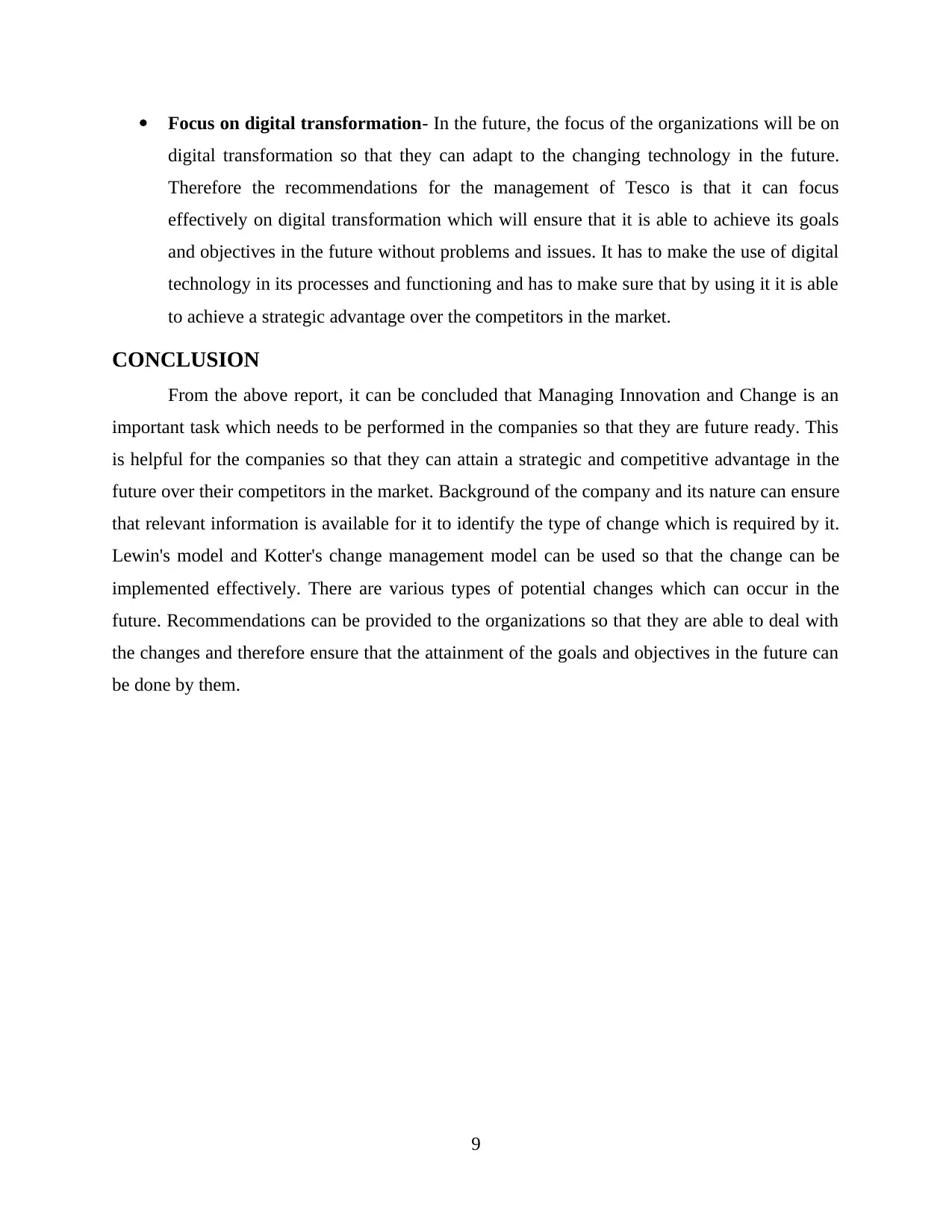
Focus on digital transformation- In the future, the focus of the organizations will be on
digital transformation so that they can adapt to the changing technology in the future.
Therefore the recommendations for the management of Tesco is that it can focus
effectively on digital transformation which will ensure that it is able to achieve its goals
and objectives in the future without problems and issues. It has to make the use of digital
technology in its processes and functioning and has to make sure that by using it it is able
to achieve a strategic advantage over the competitors in the market.
CONCLUSION
From the above report, it can be concluded that Managing Innovation and Change is an
important task which needs to be performed in the companies so that they are future ready. This
is helpful for the companies so that they can attain a strategic and competitive advantage in the
future over their competitors in the market. Background of the company and its nature can ensure
that relevant information is available for it to identify the type of change which is required by it.
Lewin's model and Kotter's change management model can be used so that the change can be
implemented effectively. There are various types of potential changes which can occur in the
future. Recommendations can be provided to the organizations so that they are able to deal with
the changes and therefore ensure that the attainment of the goals and objectives in the future can
be done by them.
9
digital transformation so that they can adapt to the changing technology in the future.
Therefore the recommendations for the management of Tesco is that it can focus
effectively on digital transformation which will ensure that it is able to achieve its goals
and objectives in the future without problems and issues. It has to make the use of digital
technology in its processes and functioning and has to make sure that by using it it is able
to achieve a strategic advantage over the competitors in the market.
CONCLUSION
From the above report, it can be concluded that Managing Innovation and Change is an
important task which needs to be performed in the companies so that they are future ready. This
is helpful for the companies so that they can attain a strategic and competitive advantage in the
future over their competitors in the market. Background of the company and its nature can ensure
that relevant information is available for it to identify the type of change which is required by it.
Lewin's model and Kotter's change management model can be used so that the change can be
implemented effectively. There are various types of potential changes which can occur in the
future. Recommendations can be provided to the organizations so that they are able to deal with
the changes and therefore ensure that the attainment of the goals and objectives in the future can
be done by them.
9
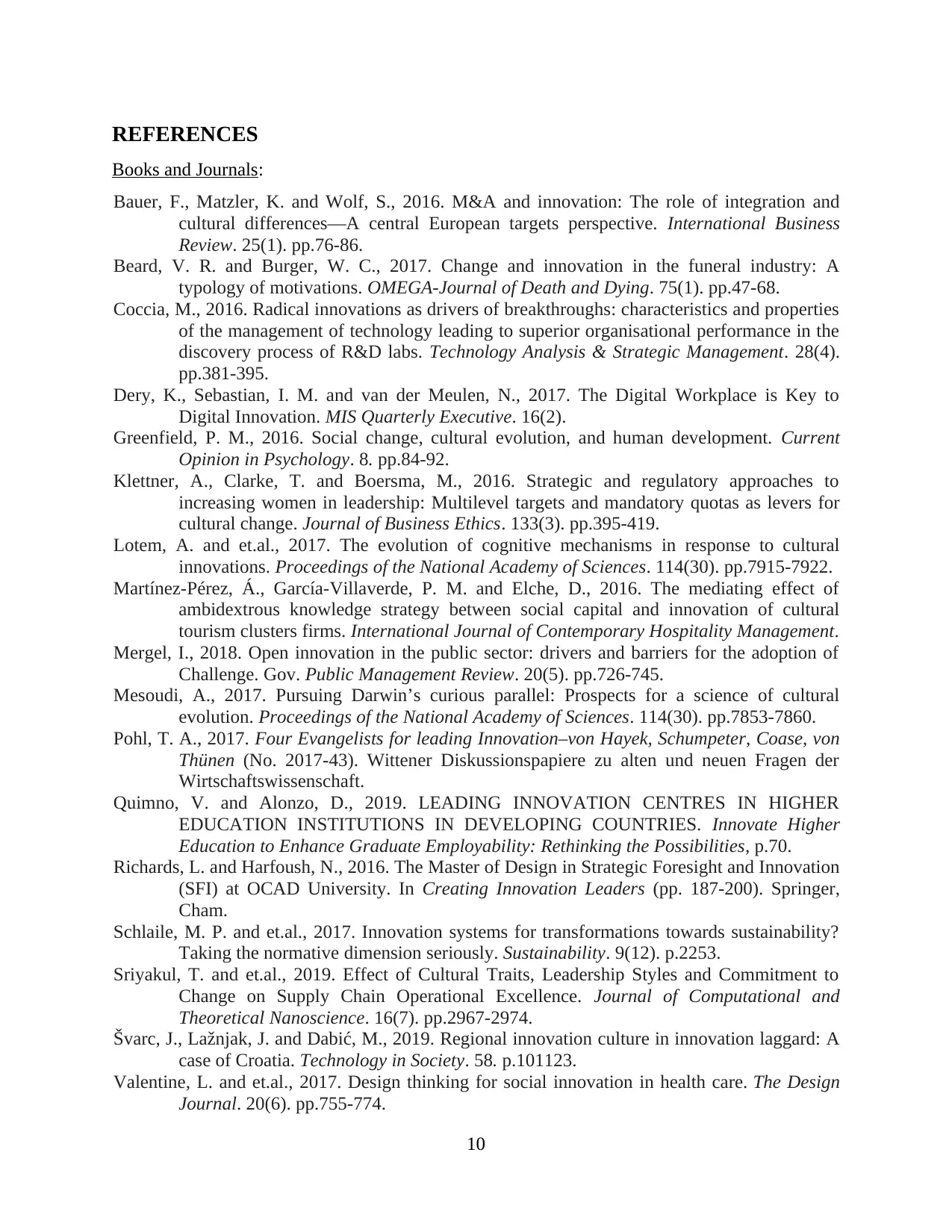
REFERENCES
Books and Journals:
Bauer, F., Matzler, K. and Wolf, S., 2016. M&A and innovation: The role of integration and
cultural differences—A central European targets perspective. International Business
Review. 25(1). pp.76-86.
Beard, V. R. and Burger, W. C., 2017. Change and innovation in the funeral industry: A
typology of motivations. OMEGA-Journal of Death and Dying. 75(1). pp.47-68.
Coccia, M., 2016. Radical innovations as drivers of breakthroughs: characteristics and properties
of the management of technology leading to superior organisational performance in the
discovery process of R&D labs. Technology Analysis & Strategic Management. 28(4).
pp.381-395.
Dery, K., Sebastian, I. M. and van der Meulen, N., 2017. The Digital Workplace is Key to
Digital Innovation. MIS Quarterly Executive. 16(2).
Greenfield, P. M., 2016. Social change, cultural evolution, and human development. Current
Opinion in Psychology. 8. pp.84-92.
Klettner, A., Clarke, T. and Boersma, M., 2016. Strategic and regulatory approaches to
increasing women in leadership: Multilevel targets and mandatory quotas as levers for
cultural change. Journal of Business Ethics. 133(3). pp.395-419.
Lotem, A. and et.al., 2017. The evolution of cognitive mechanisms in response to cultural
innovations. Proceedings of the National Academy of Sciences. 114(30). pp.7915-7922.
Martínez-Pérez, Á., García-Villaverde, P. M. and Elche, D., 2016. The mediating effect of
ambidextrous knowledge strategy between social capital and innovation of cultural
tourism clusters firms. International Journal of Contemporary Hospitality Management.
Mergel, I., 2018. Open innovation in the public sector: drivers and barriers for the adoption of
Challenge. Gov. Public Management Review. 20(5). pp.726-745.
Mesoudi, A., 2017. Pursuing Darwin’s curious parallel: Prospects for a science of cultural
evolution. Proceedings of the National Academy of Sciences. 114(30). pp.7853-7860.
Pohl, T. A., 2017. Four Evangelists for leading Innovation–von Hayek, Schumpeter, Coase, von
Thünen (No. 2017-43). Wittener Diskussionspapiere zu alten und neuen Fragen der
Wirtschaftswissenschaft.
Quimno, V. and Alonzo, D., 2019. LEADING INNOVATION CENTRES IN HIGHER
EDUCATION INSTITUTIONS IN DEVELOPING COUNTRIES. Innovate Higher
Education to Enhance Graduate Employability: Rethinking the Possibilities, p.70.
Richards, L. and Harfoush, N., 2016. The Master of Design in Strategic Foresight and Innovation
(SFI) at OCAD University. In Creating Innovation Leaders (pp. 187-200). Springer,
Cham.
Schlaile, M. P. and et.al., 2017. Innovation systems for transformations towards sustainability?
Taking the normative dimension seriously. Sustainability. 9(12). p.2253.
Sriyakul, T. and et.al., 2019. Effect of Cultural Traits, Leadership Styles and Commitment to
Change on Supply Chain Operational Excellence. Journal of Computational and
Theoretical Nanoscience. 16(7). pp.2967-2974.
Švarc, J., Lažnjak, J. and Dabić, M., 2019. Regional innovation culture in innovation laggard: A
case of Croatia. Technology in Society. 58. p.101123.
Valentine, L. and et.al., 2017. Design thinking for social innovation in health care. The Design
Journal. 20(6). pp.755-774.
10
Books and Journals:
Bauer, F., Matzler, K. and Wolf, S., 2016. M&A and innovation: The role of integration and
cultural differences—A central European targets perspective. International Business
Review. 25(1). pp.76-86.
Beard, V. R. and Burger, W. C., 2017. Change and innovation in the funeral industry: A
typology of motivations. OMEGA-Journal of Death and Dying. 75(1). pp.47-68.
Coccia, M., 2016. Radical innovations as drivers of breakthroughs: characteristics and properties
of the management of technology leading to superior organisational performance in the
discovery process of R&D labs. Technology Analysis & Strategic Management. 28(4).
pp.381-395.
Dery, K., Sebastian, I. M. and van der Meulen, N., 2017. The Digital Workplace is Key to
Digital Innovation. MIS Quarterly Executive. 16(2).
Greenfield, P. M., 2016. Social change, cultural evolution, and human development. Current
Opinion in Psychology. 8. pp.84-92.
Klettner, A., Clarke, T. and Boersma, M., 2016. Strategic and regulatory approaches to
increasing women in leadership: Multilevel targets and mandatory quotas as levers for
cultural change. Journal of Business Ethics. 133(3). pp.395-419.
Lotem, A. and et.al., 2017. The evolution of cognitive mechanisms in response to cultural
innovations. Proceedings of the National Academy of Sciences. 114(30). pp.7915-7922.
Martínez-Pérez, Á., García-Villaverde, P. M. and Elche, D., 2016. The mediating effect of
ambidextrous knowledge strategy between social capital and innovation of cultural
tourism clusters firms. International Journal of Contemporary Hospitality Management.
Mergel, I., 2018. Open innovation in the public sector: drivers and barriers for the adoption of
Challenge. Gov. Public Management Review. 20(5). pp.726-745.
Mesoudi, A., 2017. Pursuing Darwin’s curious parallel: Prospects for a science of cultural
evolution. Proceedings of the National Academy of Sciences. 114(30). pp.7853-7860.
Pohl, T. A., 2017. Four Evangelists for leading Innovation–von Hayek, Schumpeter, Coase, von
Thünen (No. 2017-43). Wittener Diskussionspapiere zu alten und neuen Fragen der
Wirtschaftswissenschaft.
Quimno, V. and Alonzo, D., 2019. LEADING INNOVATION CENTRES IN HIGHER
EDUCATION INSTITUTIONS IN DEVELOPING COUNTRIES. Innovate Higher
Education to Enhance Graduate Employability: Rethinking the Possibilities, p.70.
Richards, L. and Harfoush, N., 2016. The Master of Design in Strategic Foresight and Innovation
(SFI) at OCAD University. In Creating Innovation Leaders (pp. 187-200). Springer,
Cham.
Schlaile, M. P. and et.al., 2017. Innovation systems for transformations towards sustainability?
Taking the normative dimension seriously. Sustainability. 9(12). p.2253.
Sriyakul, T. and et.al., 2019. Effect of Cultural Traits, Leadership Styles and Commitment to
Change on Supply Chain Operational Excellence. Journal of Computational and
Theoretical Nanoscience. 16(7). pp.2967-2974.
Švarc, J., Lažnjak, J. and Dabić, M., 2019. Regional innovation culture in innovation laggard: A
case of Croatia. Technology in Society. 58. p.101123.
Valentine, L. and et.al., 2017. Design thinking for social innovation in health care. The Design
Journal. 20(6). pp.755-774.
10
⊘ This is a preview!⊘
Do you want full access?
Subscribe today to unlock all pages.

Trusted by 1+ million students worldwide
1 out of 13
Related Documents
Your All-in-One AI-Powered Toolkit for Academic Success.
+13062052269
info@desklib.com
Available 24*7 on WhatsApp / Email
![[object Object]](/_next/static/media/star-bottom.7253800d.svg)
Unlock your academic potential
Copyright © 2020–2025 A2Z Services. All Rights Reserved. Developed and managed by ZUCOL.




